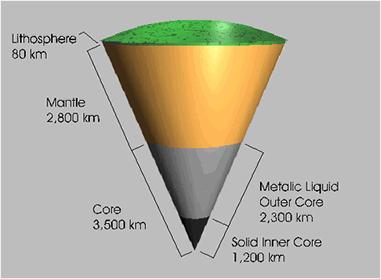
How Earth's Outer Layers Wander Back and Forth

The entire outermost part of Earth is able to wander over the rest of the planet, and now researchers say in a new study detailed in the Nov. 8 issue of the journal Nature that they can explain how it can mysteriously return back the way it was.
The planet's solid exterior — its crust and most of its mantle layer — at times drifts over its core. To envision this, imagine that a peach's flesh somehow became detached from the fruit's pit and was free to move about over it.
These shifts can prove rather extreme. A person sitting on the Earth could have seen the pole apparently wander up to 50 degrees and then return close to its original location, all in tens of millions of years.
"If it happened today, a shift of 50 degrees one way might put Boston near the north pole, while a shift in the opposite direction would bring Boston near the equator," said study researcherJessica Creveling, a geologist and geochemist now at the California Institute of Technology. "Not surprisingly, these dramatic shifts have been linked to major changes in nearly all aspects of the Earth system, including the carbon cycle, climate, evolution." [Earth Quiz: Mysteries of the Blue Marble]
Wandering poles
This movement of Earth's outermost layers is known as "true polar wander." It differs from the motions of the plates making up Earth's crust, known as plate tectonics.
Scientists think they understand the processes behind the original shift in the poles — that is, what causes the tip-over.
Get the world’s most fascinating discoveries delivered straight to your inbox.
"This shift is due to large-scale flow in the Earth's rocky interior known as mantle convection, the same process that drives continental drift and plate tectonics," Creveling said. These include "superswells" beneath southern Africa and the Pacific Ocean, which cause the Earth underneath them to lift.
However, the reasons the poles returned to their original locations remained a mystery.
"This is the most puzzling aspect of all," said study researcher Jerry Mitrovica, a geophysicist at Harvard University. "Why would the Earth return to its original orientation?"
Now the researchers suspect they might have two answers to this puzzle that have to do with the shape of the Earth and the elasticity of its tectonic plates.
Earth's bulge
Computer simulations run for the study first looked at the planet's equatorial bulge — that is, the way Earth swells around the middle.
"This increased girth is due to the Earth's rotation, which causes the equator to bulge outwards," Creveling said.
The Earth's bulge is a bit larger than one might expect just from its rotation due to the flow of rock in Earth's mantle layer.
"This extra bulge or fatness acts to stabilize the Earth's rotation just like the heavy weight at the bottom of a plastic punching bag toy will act to bring the bag back to being vertical if it is punched sideways," Creveling said. "The excess bulge of the Earth acts as a self-righting mechanism for the Earth's rotation."
Elastic tectonic plates
The computer simulations also looked at the elasticity (a measure of how a material deforms under stress) of Earth's tectonic plates.
"It turns out that if the pole moves on the Earth's surface, the plates all get deformed a little bit, just like small elastic bands," Creveling said. "And just like elastic bands that are stretched, the plates will want to go back to their original size. This elastic strength may have also played a role in the oscillatory return of the pole in the dramatic true polar wander events."
One piece of evidence suggesting this elasticity plays a role in the return trip of the poles "is the fact that these tip-over-and-back events seemed to happen when the Earth's continents were gathered together into one 'supercontinent,' a process that we know has repeated a number of times in Earth history," Creveling said. (The last supercontinent, which existed 200 million years ago, was called Pangaea).
Mitrovica noted that the current shape of the Earth and the fact that it now has lots of tectonic plates and spread-out continents means that conditions are not favorable for a tip-over event.
"It won't happen again anytime soon," Mitrovica told OurAmazingPlanet.
Future research can investigate how rare or how common these polar wander events were.
"Once this is better established, it will be important to study the way in which the Earth system was impacted," Mitrovica said.
This story was provided by OurAmazingPlanet, a sister site to LiveScience. Follow OurAmazingPlanet for the latest in Earth science and exploration news on Twitter @OAPlanet. We're also on Facebook & Google+.

 Live Science Plus
Live Science Plus





